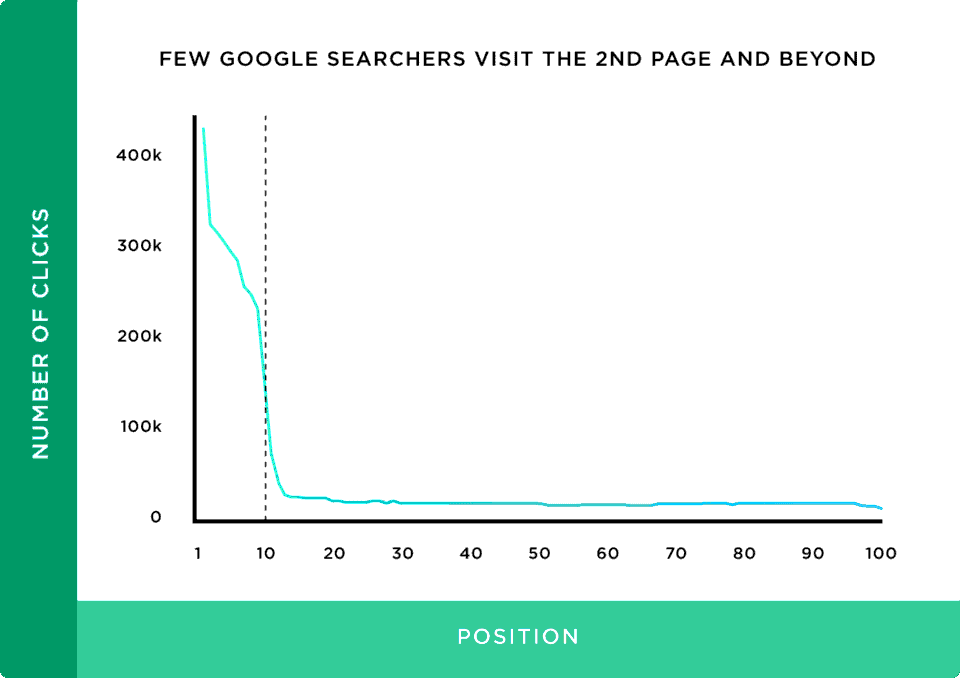
Ever since the advent of eCommerce stores and websites, a new revolution in the shopping habits and patterns of the global population was noticed. But it wasn’t until the pandemic when things really came to a head.
In a state of worldwide lockdown, where fear prevailed and restrictions were placed on the movement of masses — the need to go out to shop was high, but so was the dread of getting infected. And ultimately, the shift to online shopping was witnessed in large numbers. From essentials to retail therapy, these web-based stores had to be ready to cater to the people.
But amidst a stockpile of innumerable stores, how do you choose which one to buy from?
This is where you need to focus on building a search engine optimized store because more often than not, search engine users don’t go beyond the first page of search results. In fact, only 0.78% of Google searchers click on something from the second page.

So, only the stores that occupy the top 10 positions for relevant keywords enjoy the traffic, leads, and conversions coming their way.
Observing this was what led us to curate our own Top 10 list — one that counts down the best ways to optimize your eCommerce website in a way that helps rank it on that first search result page.
Now, although we cannot promise that following these ideas would instantly get you there, we can assure you that you’d be closer to first page results than ever. Let’s dive in.
Top 10 Tips To Optimizing Your eCommerce Store
Following are our top recommendations for what you can and should do to optimize your online store.
Table of Contents
1. Target the Right Keywords
Keywords are a vital part of any optimization process. These are the words and phrases that users around the world input in the search engines when searching for particular products, services, or even just information. Though it can largely vary from person to person, there are some words that would be repeatedly used for a particular item and that forms the keyword for the same.
Choosing the right keywords is quintessential so as to enhance your visibility to the target audience. These should be not only relevant to your industry but also tie appropriately with your niche. This helps bring in more organic traffic to your site.
Tools like Google Ads can help you determine what keywords are important in your line of business, but you should take care to avoid the ones that are highly competitive or too broad or ambiguous. Additionally, the use of long-tail keywords can also prove helpful.
2. Customize your URLs
We’re sure you must have come across some super long URLs in your search. For instance, have you noticed the length of the links when you share a product listing with your friends or when you are simply looking for a good desktop wallpaper on Google? Yes, those long hyperlinks — well, they aren’t going to work if you want to rank higher than your current position.
As a rule, always remember that your URL needs to be short, crisp, and readable, something that actually makes sense when read. If your link comprises random alphabets, numerals, and characters mixed in, it becomes hard for any user to remember or make sense of it simply by looking at it. However, a to-the-point hyperlink establishes a natural feel and a sense of trustworthiness in the business. Being able to include important keywords in the same is an added bonus that further helps in the optimization process.
Customizing URLs is one of the many optimizations you can readily carry out in SEO-ready eCommerce platforms like BigCommerce and Shopify.
3. Write Convincing Meta Titles and Descriptions
Meta Titles refer to the page name that you see on a search engine result page (SERP) while the meta description is the explanation written underneath it, that attempts to give a brief summary of what the page is about in only 160 characters.
What makes it essential to work on these is the fact that these will give the first impression to any searcher and if these are compelling and one-of-a-kind, the potential customer might just open the page out of intrigue. Thus, it is important that you share your most convincing statements in a limited character count in these positions, especially for your product pages, to optimize them further.
4. Optimize with Images
You never really think about what we are naming a simple image when working on creating a website or making additions to it. But what you don’t realize is that these insignificant seeming texts can make a major difference to the way your website is crawled and perceived by search engines.
The name of the image can also work in taking your store to a higher ranking because this is another area where you can easily insert contextual keywords. This would make it simpler for the search engine to understand what the image is about, while also ensuring that if the image is unable to load on the user’s end due to any reason, the text displayed will let them know what the image consisted of.

You can also try to include the colors and styles of a product when naming their image to give them an additional boost. In addition, using an image converter to efficiently compress your images will ensure faster loading time.
5. Keep ‘Out of Stock’ Pages Live
Those managing an online store often decide to make product pages inactive whose corresponding items have been sold out or are currently out of stock. However, they fail to notice that this is constantly creating a stream of broken links because now when a customer clicks on them, they reach a 404 error page. This can be extremely disheartening for someone who was really interested in buying that certain product.
So our suggestion would be to keep those pages live regardless of their availability. Instead of taking them offline, you can create a Call-to-Action button there which would enable the buyer to receive a notification as soon as the item is back in stock. This will kill two birds with one stone by also adding to your consumer database.
6. Ensure a Balanced Link Structure
There is something to be said about a site’s balanced linking structure. With the various inbound and outbound links, it can be a precarious balancing act, but one that is necessary for a good SERP ranking. Simultaneously, it is also important to have these links to and from credible websites with a high domain authority (DA).
If you are mistakenly linking to a site that has a high spam score, the search engine can suspect your store to be fraudulent too, which in turn will lead to it bringing down your rank instead of moving it up. Also, if the difference between the number of pages linking to yours in contrast to the number of pages you are linking to is exceedingly high, that can also alert the search engine algorithms to suspicious activity or behavior.
7. Use an Easy to Understand Layout
An easy layout is one where it is aptly clear to the visitor as to what action will lead to what result. For instance, if the consumer knows that clicking on a certain product name will take you to their description page, the experience becomes smooth. However, if clicking on the name takes you to a page defining the entire category that item falls under and listing all the kinds of products that are included within, it can be confusing.
No user would want to brainstorm over what step to take next to reach the desired field or page and would thus simply leave the site and go elsewhere to look for the item. Keeping this in mind, the search engine crawlers also look for a neatly laid structure and in absence of one, they would simply push the website down in terms of ranking because they work to create an optimal experience for the customer.
8. Go Local
This essentially means that you tie your store with your local geographical location as well. Even in the absence of a brick-and-mortar facility, you can do this through your SEO techniques.
All you need to do is list your business under Google My Business (GMB) and complete your profile. Keep updating it from time to time and it would ensure that your store has higher visibility in the area you are targeting. Alternatively, you can also create an additional page on your site that focuses on a particular region, and by optimizing its elements, you can quite easily create a local landing page for your trade.

It is also noteworthy that GMB allows customers to rate and review the businesses listed thereon which can be an added bonus.
9. Make it Mobile-friendly
Mobile optimization is one of the hottest trends prevailing right now in regards to eCommerce websites. This is because customers frequently prefer to shop while going through their cellular devices instead of making the purchase through their computers.
It means that the need to provide a user-friendly and smooth experience over mobiles is now the need of the hour because if that experience fails, there is a good chance that the consumer might not return to the site at all to avoid the unnecessary hassle and frustration they faced on their previous attempt. On the contrary, if the usability is well-defined, the visitors might return over and over, which tells the search engines that yours is a credible site. This would automatically be witnessed by the increase in your rank.
8. Allow Customers to Rate and Review
Ratings and reviews of a product by previous buyers are considered one of the most important ways by which a new consumer ascertains whether they should or shouldn’t invest in an item. This is also true for a site’s rating and review.
By letting your customers leave feedback about the product they purchased from you, you are displaying the confidence you have in your items while also ensuring that new visitors can make an informed decision. This propels the shoppers towards your store because buying something when they have a string of good reviews to support their decision is what they would prefer over all else.
Simultaneously, if your website itself has been rated high with good comments left about it, it encourages the new and potential users to visit your store for their shopping needs as you are now considered more reliable.
Wrapping Up
Ultimately what matters, in the long run, is making a name for your brand such that the customers directly input your name in the search engine whenever they are looking to buy a product that your store deals in. But until then, to draw visitors and customers in, ranking high in search results should be a priority for your business.
Try out these tips and tricks today, and we’re sure you’ll love the results you gain.
All the best and have fun!
Author Bio
Lucy Manole is a creative content writer and strategist at Marketing Digest. She specializes in writing about EdTech, productivity, career, technology and entrepreneurship. When she is not writing or editing, she spends time reading books, cooking and listening to music.
